JAKARTA- Indonesia’s annual inflation rate eased more than expected in May, data from the statistics bureau showed on Monday, remaining within the central bank’s 1.5 percent to 3.5 percent target range.
The May headline inflation rate was 2.84 percent , down from 3 percent in April. A Reuters poll of analysts had expected an inflation rate of 2.94 percent in May.
The annual core inflation rate, however, picked up slightly to 1.93 percent in May, from 1.82 percent the previous month. The poll had predicted a 1.86 percent rate in May.
Inflation has stayed within Bank Indonesia’s target range since the middle of last year. The central bank has delivered a cumulative 275 basis point rate hikes since mid-2022.
Monetary policymakers are still monitoring the rupiah’s recent weakness against the US dollar as it could bring imported inflation into Southeast Asia’s largest economy.
BI’s last rate hike in April was in response to the rupiah falling to its lowest against the dollar since 2020.
The decline in the inflation rate was in line with the seasonal pattern after Eid al-Fitr, when demand usually falls, acting head of Statistics Indonesia, Amalia AdininggarWidyasanti, told a press briefing.
Volatile food inflation also eased last month, as rice prices continued to fall on a monthly basis amid ample supplies during harvest season.
Meanwhile, BI is not looking at an across-the-board cut in the reserve requirement ratio (RRR) for banks even as it expands a scheme offering relief for lending to certain sectors to support economic growth, a deputy governor said on Monday.
From June 1, lending to sectors such as automotive, trade, electricity, gas, and water utilities qualify for the incentives for relief from the 9 percent RRR rate.
Banks can reduce their required reserve levels by up to 4 percent under the rules, which BI estimates could release up to 115 trillion rupiah ($7.1 billion) of liquidity throughout 2024.
“The intention is to provide an incentive to those who lend. If we cut the RRR, it will give liquidity to banks, but they may not channel that towards credit,” Deputy Governor Juda Agung said.
“We will continue to monitor banks’ liquidity levels, credit growth and the direction of interest rate (policy), because this is a policy mix,” Juda told reporters.
BI has raised interest rates a total of 275 basis points since mid-2022 and increased banks’ reserve requirement ratio (RRR) by 550 bps to 9 percent in its post-pandemic tightening cycle.
BI officials have said its policy mix of pairing high interest rates with the liquidity incentive is intended to help weather global financial market volatility, which has weakened the rupiah, without hurting domestic growth too much.
For more than a year, the central bank has allowed banks to hold a lower level of reserves for lending to certain sectors, such as property and natural resources processing, and it flagged the expansion of the incentive scheme earlier this year.
BI in April delivered a surprise rate hike after the rupiah fell to its lowest since 2020.
Governor Perry Warjiyo last month said the rate hike was sufficient to attract capital inflows and stabilize the rupiah, but the currency has since dropped again by more than 1 percent.





